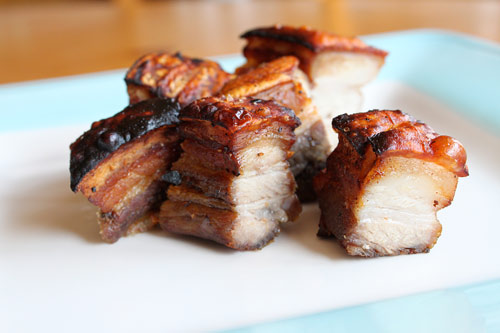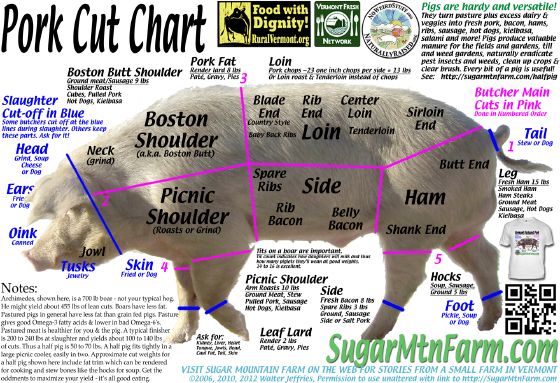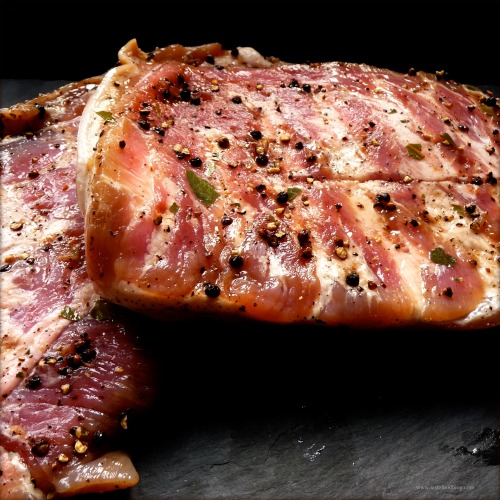Not long ago, I tried pork belly for the first time.
The first -- and for many years the only -- time I heard of pork bellies was in the Dan Aykroyd/Eddie Murphy movie Trading Places (1983) -- which still holds up, by the way.
Never heard a whisper about pork bellies after that. But all of a sudden in the past five or six years, it seems every other Food Network show has some chef who makes pork belly at least once per episode and gets all excited and drooly-mouthed about it as if it's some incredible delicacy. Especially on Top Chef.

Top Chef season 6 contestant Kevin Gillespie (the guy with red hair & beard who made pork about 90 ways)'s smoked pork belly with pickled apples and pureed peanut sauce.
(Photo from Food Gal)
In spite of all their enthusiasm,pork belly has never looked that appetizing to me because there's usually a big hunk of fat on top.

Pork belly, with the fat on top crispy.
(Photo from Simple Comfort Food)
But recently I was at a restaurant that had pork belly on the menu so I thought, what the heck, I'll try it and see what all the fuss is about.
It tasted like a pork chop with a lot of fat on top.
But I did suspect that pork bellies and bacon have something to do with each other, and that if you cut a pork belly vertically, you'd get a strip of bacon. Was I correct? What exactly is the relationship between pork bellies and bacon?

Chart of cuts of pork from the pig. The section marked Side is where the belly and the bacon come from. Even though this chart calls it the "side," most people say the pork belly comes from -- you guessed it -- the belly.
(Chart from Sugar Mountain Farm)

Raw pork belly with the skin still on. The Food Network described pork belly as "a fatty slab of meat." Yup.
(Photo from A Knife's Work)


Home-made smoked bacon, from pork belly.
(Photo from AmazingRibs.com)
Here are some recipes in detail:

Home-cured bacon, with spices still on top, prior to slicing.
(Photo from TasteFood)
Give it a try. Let us know how your bacon turns out.
Oh, and by the way, pork bellies haven't been traded as a futures commodity since 2011. Which may seem like a mistake because their fortunes have really taken off. But actually this is why they're no longer traded. The bellies don't get frozen & stored for later use, which is what made them ideal as a futures commodity. Now, bacon & the pork bellies themselves are so in demand, they're eaten all year round. Paradoxically, there's no longer a future in 'em. Har har.
Some futures traders lament their passing from the trading floor. Apparently, pork bellies were a commodity for the most hard-core trader. They could make you or break you.

Photo from the day the Chicago Mercantile Exchange began trading pork bellies -- September 18, 1961. It was a good 50 years.
(Photo sourced from The '60s at 50)
Sources
Seattle Met, Bacon vs. Pork Belly, March 2, 2012
Food Network, Pork Belly Ribs and Bacon Guide
Sugar Mountain Farm, What Good is a Pig: Cuts of Pork, Nose-to-Tail, April 4, 2014
Cool Material, How to Make Bacon from Scratch
The Guardian, The secrets of home-curing your own bacon, March 16, 2011
A Knife's Work, Roasted Pork Belly
Jacob Burton, Difference between Sodium Nitrite, Nitrate, & Pink Curing Salt
Livestrong, Sodium Nitrate vs. Sodium Nitrite, October 21, 2013
Investopedia, Commodities: Pork Bellies and Pork Bellies: Definition
Trade in Pork Bellies Comes to an End, but the Lore Lives, The New York Times, July 30, 2011
The first -- and for many years the only -- time I heard of pork bellies was in the Dan Aykroyd/Eddie Murphy movie Trading Places (1983) -- which still holds up, by the way.
Never heard a whisper about pork bellies after that. But all of a sudden in the past five or six years, it seems every other Food Network show has some chef who makes pork belly at least once per episode and gets all excited and drooly-mouthed about it as if it's some incredible delicacy. Especially on Top Chef.

Top Chef season 6 contestant Kevin Gillespie (the guy with red hair & beard who made pork about 90 ways)'s smoked pork belly with pickled apples and pureed peanut sauce.
(Photo from Food Gal)
In spite of all their enthusiasm,pork belly has never looked that appetizing to me because there's usually a big hunk of fat on top.

Pork belly, with the fat on top crispy.
(Photo from Simple Comfort Food)
But recently I was at a restaurant that had pork belly on the menu so I thought, what the heck, I'll try it and see what all the fuss is about.
It tasted like a pork chop with a lot of fat on top.
But I did suspect that pork bellies and bacon have something to do with each other, and that if you cut a pork belly vertically, you'd get a strip of bacon. Was I correct? What exactly is the relationship between pork bellies and bacon?
- The short answer is yes, my guess was correct. Bacon is sliced from the pork belly. But let me back up a second and give you the whole low-down.
- As you would suspect, the pork belly is cut from the belly of the pig.

Chart of cuts of pork from the pig. The section marked Side is where the belly and the bacon come from. Even though this chart calls it the "side," most people say the pork belly comes from -- you guessed it -- the belly.
(Chart from Sugar Mountain Farm)

Raw pork belly with the skin still on. The Food Network described pork belly as "a fatty slab of meat." Yup.
(Photo from A Knife's Work)
- Once you've got a slab of pork belly, you can go in either of two directions. You can either roast or fry the belly or otherwise make that your dish of choice. Or you can transform the pork belly into none other than our good friend bacon!
- Bacon is pork belly that has been cured so it won't go bad, smoked, and then sliced into the familiar slices we all know and love.
- Curing means you coat it in a ton of salt. This is true of any meat, but with the pork belly you need an especially large boatload of salt. This is because pork belly tends to go bad in a hurry. Unsalted, pork belly would turn rancid in about 5 days. So for the amount that's cut off the end there, you'd probably need around 3 cups of salt.
- Plus you would add some sugar. This is to help combat the saltiness and to add flavor. One guy recommends brown sugar. Someone else recommends maple syrup. Still another says to use honey.
- You'd also want to add any other kinds of spices or flavors -- black pepper, garlic, rosemary, bay leaves, whatever strikes your fancy.
- Another guy recommends adding just a touch of a preservation called saltpeter. People are afraid of it because it's in things like gunpowder, but lots of green vegetable naturally contain more saltpeter than you'd be adding to your pork belly/bacon.
- If you don't use the saltpeter, you might use pink curing salt, which is sodium nitrite. This ingredient helps to prevent botulism, and the pink helps turn the meat the nice red color we associate with deliciousness, and it also does improve the flavor to give you that deliciousness that the color promises.
- Yes, people have health concerns about sodium nitrite (or its precursor, sodium nitrate).
In general, the American Medical Association has found that the concentrations of nitrites in normal quantities of preserved meats aren't sufficient to cause cancer. However, they also report that nitrites lead to formation of modified hemoglobin proteins, [which] can lead to cellular oxygen deficiencies. [from Livestrong]

Pork belly rubbed with the cure -- in this case, curing salt, kosher salt, dark brown sugar, black pepper
(Photo from Pork Drunk)
- Once you've got your pork belly all salted & flavored up, wrap it snugly in plastic and put it in your refrigerator for about 7 days.
- When you take it out and unwrap it, you will discover it will have formed a flabby soggy looking whitish layer on top. This is called the pellicle and, yucky-looking though it may be, its appearance means you've done everything properly do this point, and it also helps seal in flavor and acts as a protective layer during the smoking. Which comes next.
- Some people buy or own a smoker and they stick their cured pork belly/almost bacon in there. Or if you have one of those barbecue drums, you could use that. Or you could use your regular old oven, but the flavor would not be as good. Because you would not really be smoking it.
- You want the temperature in your smoker/grill/BBQ thing to be on the low side, around 200 degrees, but really smoky. One guy recommends using half the coals you normally wood and adding wood that's been soaked in water for a little while so it will smoke a lot. Of course the type of wood you choose will make a difference too. Fruit woods tend to smoke a lot, as does hickory. Which is why you often hear of hickory-smoked bacon, for example.
- When you take your cured pork belly out of the smoker/BBQ/oven, it will look dang near like the bacon you're used to seeing. And that's because it has become bacon. All you need to do is slice it, and you'll say, hey! I know that meat! That's bacon!

Home-made smoked bacon, from pork belly.
(Photo from AmazingRibs.com)
- Some people say to refrigerate for a while before slicing; others say slice and then refrigerate or fry it up as soon as you want to eat it.
- Oh, and pancetta is essentially the same thing. You take a pork belly, cure it, & smoke it. The difference is you use a specific recipe of spices in your cure rub.
Here are some recipes in detail:
- How to Make Bacon from Scratch with a BBQ -- from Cool Material
- Home-Cured Pork Belly Bacon with a smoker -- from Primal Palate (lots of photos)
- Makin' Bacon from Scratch with a smoker -- from AmazingRibs.com (lots of detail; kind of hard to read)
- Making Bacon from Pork Belly with a smoker -- from How to BBQ Right (with pink curing salt & maple syrup)
- How to Make Bacon on Your Charcoal Grill or Smoker -- from BBQ4Dummies (with lots of really helpful tips all the way through the process)
- How to Make DIY Bacon with a gas or charcoal grill -- from Fine Cooking
- Real Homemade American Bacon on a gas grill -- from The Paupered Chef (with hickory sawdust)
- Home Cured Pancetta -- from Mamaglia (with lots of helpful, labeled pictures)

Home-cured bacon, with spices still on top, prior to slicing.
(Photo from TasteFood)
Give it a try. Let us know how your bacon turns out.
Oh, and by the way, pork bellies haven't been traded as a futures commodity since 2011. Which may seem like a mistake because their fortunes have really taken off. But actually this is why they're no longer traded. The bellies don't get frozen & stored for later use, which is what made them ideal as a futures commodity. Now, bacon & the pork bellies themselves are so in demand, they're eaten all year round. Paradoxically, there's no longer a future in 'em. Har har.
Some futures traders lament their passing from the trading floor. Apparently, pork bellies were a commodity for the most hard-core trader. They could make you or break you.
There was the balding trader whose wig was seen as a gauge of the market’s volatility; on the craziest days, the wig’s part ran ear to ear, [Chicago Mercantile Exchange futures reporter Gary] Wilhelmi recalled. There was the analyst who died right there. “Bellies killed him,” Mr. Wilhelmi said. [from the New York Times]

Photo from the day the Chicago Mercantile Exchange began trading pork bellies -- September 18, 1961. It was a good 50 years.
(Photo sourced from The '60s at 50)
Sources
Seattle Met, Bacon vs. Pork Belly, March 2, 2012
Food Network, Pork Belly Ribs and Bacon Guide
Sugar Mountain Farm, What Good is a Pig: Cuts of Pork, Nose-to-Tail, April 4, 2014
Cool Material, How to Make Bacon from Scratch
The Guardian, The secrets of home-curing your own bacon, March 16, 2011
A Knife's Work, Roasted Pork Belly
Jacob Burton, Difference between Sodium Nitrite, Nitrate, & Pink Curing Salt
Livestrong, Sodium Nitrate vs. Sodium Nitrite, October 21, 2013
Investopedia, Commodities: Pork Bellies and Pork Bellies: Definition
Trade in Pork Bellies Comes to an End, but the Lore Lives, The New York Times, July 30, 2011
No comments:
Post a Comment
If you're a spammer, there's no point posting a comment. It will automatically get filtered out or deleted. Comments from real people, however, are always very welcome!